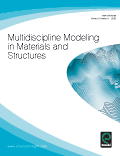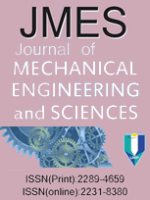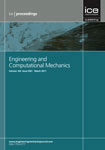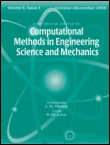
International Journal of Multiphysics
Scope & Guideline
Pioneering Research for a Multiphysical Future
Introduction
Aims and Scopes
- Multiphysics Modeling and Simulation:
The journal emphasizes the development and application of multiphysics modeling techniques, integrating various physical phenomena such as fluid dynamics, structural mechanics, and thermal analysis. - Computational Techniques and Algorithms:
A strong focus on advanced computational methods, including finite element analysis, computational fluid dynamics, and machine learning algorithms, to analyze and solve complex engineering problems. - Interdisciplinary Applications:
Research spans a wide array of disciplines, including but not limited to mechanical, civil, electrical, and environmental engineering, showcasing the relevance of multiphysics in diverse applications. - Innovative Engineering Solutions:
The journal promotes studies that provide innovative solutions to engineering challenges, particularly through the integration of emerging technologies such as artificial intelligence, quantum algorithms, and advanced materials. - Environmental and Energy Systems:
Research addressing environmental challenges and energy systems, focusing on sustainable practices, renewable energy sources, and the impact of engineering decisions on ecological systems.
Trending and Emerging
- Artificial Intelligence and Machine Learning Integration:
An increasing number of studies are leveraging AI and machine learning techniques to enhance multiphysics modeling and prediction capabilities, reflecting the growing importance of data-driven approaches in engineering. - Sustainable and Green Engineering Practices:
Research focusing on sustainable engineering solutions, particularly in energy systems and environmental impact assessments, is gaining traction, aligning with global priorities for sustainability and ecological preservation. - Quantum Computing Applications:
Emerging themes include the application of quantum algorithms in solving complex multiphysics problems, indicating a forward-looking approach to utilizing cutting-edge computational technologies. - Advanced Materials and Nanotechnology:
There is a notable rise in research concerning advanced materials, particularly nanomaterials, and their multiphysical properties, showcasing the journal's engagement with innovative material science. - Smart Systems and IoT Integration:
Studies exploring the integration of multiphysics modeling with smart systems and the Internet of Things (IoT) are on the rise, reflecting contemporary trends in automation and real-time data processing.
Declining or Waning
- Traditional Structural Analysis:
There appears to be a decline in publications solely focused on conventional structural analysis methods, as the field increasingly favors integrated multiphysics approaches that encompass fluid-structure interactions and dynamic responses. - Basic Fluid Dynamics Studies:
Research centered solely on fundamental fluid dynamics, without the integration of multiphysics considerations, has become less prominent as the journal encourages more complex interactions involving thermal and mechanical aspects. - Static and Low-Dimensional Systems:
Studies focusing on static systems or low-dimensional analyses are decreasing, as the trend moves towards more dynamic and high-dimensional modeling that reflects real-world complexities. - Conventional Material Testing:
There is a noticeable reduction in papers dedicated to traditional material testing methods, as the journal trends towards innovative materials and their multiphysical interactions rather than basic testing methodologies.
Similar Journals

Journal of the Serbian Society for Computational Mechanics
Empowering Insights in Computational MethodologiesJournal of the Serbian Society for Computational Mechanics, published by the Serbian Society for Computational Mechanics, is a vital platform for advancing research and knowledge in the field of computational mechanics. Established in 2012, this journal serves the academic community by providing a forum for innovative studies, methodologies, and applications within computational mechanics, presenting valuable insights for researchers, professionals, and students alike. With an ISSN of 1820-6530 and a ranking of Q4 in Computational Mechanics, it carries an essential influence in the engineering realm, despite its current rank of 71 out of 89. The journal's commitment to scholarly excellence aims to foster collaboration and encourage interdisciplinary research, making it an important resource for those invested in the evolving landscape of computational methodologies. Although the journal currently does not offer Open Access options, it remains dedicated to disseminating knowledge that will resonate within the local and global scientific community.

Computational Thermal Sciences
Unlocking New Insights in Computational Thermal DynamicsComputational Thermal Sciences, an esteemed journal published by BEGELL HOUSE INC, presents cutting-edge research at the intersection of computational mathematics, energy engineering, and fluid dynamics. With an ISSN of 1940-2503 and an E-ISSN of 1940-2554, this journal aims to disseminate high-quality research articles, reviews, and methodologies that improve our understanding of thermal processes and their applications. Renowned for its solid impact in the field, it holds a Q3 ranking in multiple categories including Computational Mathematics and Energy Engineering for 2023. As the field evolves, the journal continues to play a pivotal role in bridging theoretical research with practical innovations, thereby catering to a diverse audience of researchers, professionals, and students. Although it operates on a subscription model, the journal ensures accessibility to significant contributions in thermal sciences from 2009 to 2024, fostering an environment of knowledge sharing and collaboration.

Multidiscipline Modeling in Materials and Structures
Innovating the future of materials science and engineering.Multidiscipline Modeling in Materials and Structures, published by EMERALD GROUP PUBLISHING LTD, serves as a vital platform at the intersection of diverse fields including materials science, mechanical engineering, and modeling and simulation. Since its inception in 2005, this journal has gained recognition for its commitment to advancing knowledge and innovation within these disciplines, boasting a commendable Q3 categorization across multiple fields as of 2023. With a robust Scopus ranking that places it in the top 60th percentile for both mechanical engineering and mechanics of materials, it stands as a credible source for researchers and practitioners seeking to stay informed on the latest methodologies and applications. The journal emphasizes the importance of collaborative approaches to complex problems in materials and structural analysis, aiming to foster interdisciplinary dialogue and generate impactful research outcomes. Although currently not open access, the journal offers subscription options that ensure access to cutting-edge studies and critical reviews relevant to professionals and students alike. Engaging with this journal not only enriches one’s understanding of the field but also contributes to the ongoing discourse and development of innovative solutions in materials and structural modeling.

Journal of Mechanical Engineering and Sciences
Fostering Collaboration in Mechanical Engineering DiscoursesThe Journal of Mechanical Engineering and Sciences (ISSN: 2289-4659, E-ISSN: 2231-8380), published by UNIV MALAYSIA PAHANG, is a prominent open access journal established in 2011, dedicated to advancing the field of mechanical engineering and associated sciences. Covering a wide array of topics from industrial manufacturing processes to computational mechanics, the journal serves as a vital platform for researchers, professionals, and students to disseminate innovative findings and methodologies. With impressive Scopus rankings, including a place in the 60th percentile for Industrial and Manufacturing Engineering, the journal holds a significant position among its peers, facilitating global academic discourse. Located in Kuantan, Pahang, Malaysia, the journal emphasizes accessibility and collaboration within the engineering community, encouraging submissions that contribute to both theoretical and applied aspects of mechanical engineering.

APPLIED MATHEMATICAL MODELLING
Elevating Mathematical Research to Address Contemporary IssuesApplied Mathematical Modelling is a premier journal published by Elsevier Science Inc, dedicated to advancing the field of applied mathematics through the dissemination of high-quality research. With an impressive Impact Factor that places it in the Q1 category for both Applied Mathematics and Modeling and Simulation, this journal has established itself as a critical resource for researchers and practitioners alike, boasting a Scopus rank of #17 out of 635 in Applied Mathematics and #15 out of 324 in Modeling and Simulation. Since its inception in 1976, it has provided a vital platform for innovative models and techniques that drive progress across various scientific disciplines. Researchers will find an extensive range of articles addressing contemporary issues and developments, making it an essential read for anyone interested in the application of mathematical frameworks to real-world problems. While the journal maintains a subscription-only access model, its impactful contributions ensure that it remains an influential voice in the landscape of applied mathematics.

Proceedings of the Institution of Civil Engineers-Engineering and Computational Mechanics
Innovating Insights for Sustainable Infrastructure SolutionsProceedings of the Institution of Civil Engineers - Engineering and Computational Mechanics is a prestigious journal published by Emerald Group Publishing Ltd, dedicated to advancing the fields of civil and structural engineering, as well as mechanics of materials. With an ISSN of 1755-0777 and E-ISSN 1755-0785, this journal serves as a critical platform for disseminating innovative research and practical insights from 2009 through 2024. As part of its commitment to academic rigor, it is categorized in the Q4 quartile for both civil and structural engineering and mechanics of materials, reflecting a unique position in the scholarly community. The journal is essential for professionals, researchers, and students aiming to stay informed on current trends, methodologies, and applications in engineering and computational mechanics. By engaging with this publication, readers gain access to crucial findings that contribute to the advancement of infrastructure and materials science, vital for developing resilient and sustainable engineering solutions.

International Journal for Computational Methods in Engineering Science & Mechanics
Bridging Theory and Application in Computational MethodsThe International Journal for Computational Methods in Engineering Science & Mechanics, published by Taylor & Francis Inc., serves as a vital resource for researchers and professionals involved in the fields of computational mathematics and mechanics. With an ISSN of 1550-2287 and an E-ISSN of 1550-2295, this journal has been a cornerstone of scholarly communication since its inception in 2005 and will continue to publish cutting-edge research through 2024. Its impressive Scopus rankings highlight its impact within the field, placing it in the top quartiles for both Computational Mechanics (Q2) and Computational Mathematics (Q3), showcasing its significance for academics striving to push the boundaries of these disciplines. The journal features high-quality peer-reviewed articles that emphasize innovative computational methods, numerical analyses, and their applications in engineering science. While currently not available as an open-access option, this publication remains an essential reference for those seeking to stay at the forefront of computational methodologies in engineering practice.

PROCEEDINGS OF THE INSTITUTION OF MECHANICAL ENGINEERS PART C-JOURNAL OF MECHANICAL ENGINEERING SCIENCE
Fostering collaboration and innovation in engineering disciplines.PROCEEDINGS OF THE INSTITUTION OF MECHANICAL ENGINEERS PART C - JOURNAL OF MECHANICAL ENGINEERING SCIENCE, published by SAGE Publications Ltd, stands as a pivotal resource in the field of mechanical engineering, encompassing a wide array of topics from advanced materials to fluid dynamics and system design. With an impact factor reflective of its esteemed reputation, as indicated by its Q2 ranking in the Mechanical Engineering category, this journal serves as a vital forum for researchers, practitioners, and students alike. The journal boasts a rich history, converging research from 1983 to 2024, showcasing innovations and advancements that shape the mechanical engineering landscape. Although it is not an open-access publication, the insights and studies published herein provide invaluable contributions to the engineering community, fostering knowledge exchange and collaborative advancements. Researchers seeking a platform for their pioneering work will find Part C an ideal venue to disseminate their findings and engage with peers in this dynamic field.

MECCANICA
Driving Progress in Mechanical Engineering and PhysicsMECCANICA, an esteemed journal published by Springer, stands at the forefront of research in the fields of Condensed Matter Physics, Mechanical Engineering, and Mechanics of Materials. Established in 1966 and continuing through 2024, this journal provides a robust platform for the dissemination of innovative research and advancements in these increasingly interconnected domains. With an impressive 2023 ranking placing it in the Q2 category across multiple fields, MECCANICA boasts a Scopus rank of #198 in Mechanical Engineering, #150 in Condensed Matter Physics, and #141 in Mechanics of Materials, highlighting its significance and influence within the scholarly community. The journal aims to foster dialogue among researchers, professionals, and students, facilitating the exchange of cutting-edge ideas and methodologies crucial for overcoming contemporary engineering and physics challenges. Readers can access a wealth of knowledge through its comprehensive articles, and while it does not currently offer open access, the journal remains instrumental in shaping the future of engineering and physical sciences.

Alexandria Engineering Journal
Fostering global collaboration in engineering advancements.Alexandria Engineering Journal is a premier open access publication dedicated to advancing the field of engineering. Published by ELSEVIER and headquartered in Amsterdam, the Netherlands, this journal has been at the forefront of disseminating innovative research since its inception in the year 2000. With its impressive Q1 ranking within the Engineering (miscellaneous) category and a notable position as #20 out of 307 in the Scopus rankings, it serves as a vital resource for scholars and practitioners alike, ensuring that cutting-edge findings reach a global audience. The journal is accessible to all since adopting open access policies in 2010, thereby facilitating the sharing of valuable insights without barriers. As we approach the convergence of years from 2000 to 2024, the Alexandria Engineering Journal continues to play a pivotal role in shaping engineering practices and underpinning significant advancements in the field.